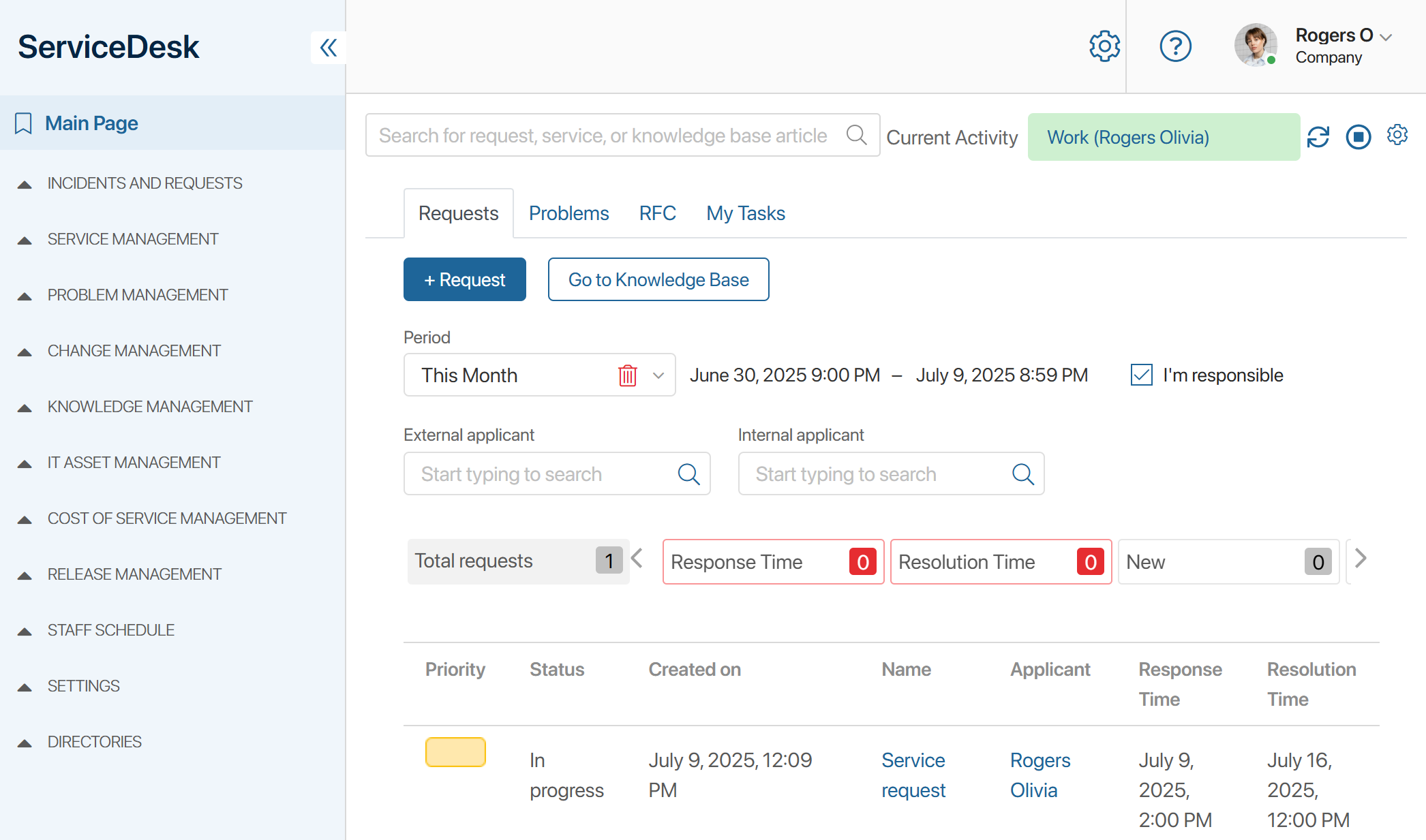The Service Desk 2.0 business solution is used to automate service management. The solution was developed using low-code tools, and its concept is based on the ITSM approach.
начало внимание
The solution can be used after it has been activated.
конец внимание
Service Desk 2.0 is designed to register, sort, and process requests for specific services. Requests can come from customers in the Live Chats workspace, through a preconfigured external portal, or be created manually by Service Desk 2.0 operators.

Key features of Service Desk 2.0
By means of Service Desk 2.0, you can:
- Set up a customer portal where they can create requests, view previously created requests, track request status changes, and view service catalogs, company news, and useful articles.
- Register and process customer requests.
- Group services provided by category and set standards for customer service.
- Identify and record the causes of similar requests.
- Plan changes in equipment or software, record results, and evaluate their impact on the services provided.
- Build a knowledge base consisting of solutions to requests and problems, as well as articles published on the preconfigured Service Desk 2.0 portal.
- Keep a record of company equipment.
- Store service contracts.
- Create employee schedules and monitor their working hours.
- Monitor the release of updates for your product: form teams of employees involved in development, define areas of responsibility, and monitor releases and sprints.
How Service Desk 2.0 is organized
The Service Desk 2.0 solution includes:
- ServiceDesk workspace, which includes:
- Incidents and Requests app and page group, where the main work with requests is carried out: their registration, storage, distribution, and processing. It also contains a report that allows you to analyze the work of operators.
- Service Management group, where you can record the services provided and group them by catalog. Request processing standards are also set here.
- Problem Management app group, which operators can use to record frequently occurring problems and known errors.
- Change Management group, where proposals are created for adding, modifying, or removing equipment or software that may affect service delivery. It also contains a report that can be used to evaluate the work done on the changes made.
- Knowledge Management group, which records all decisions on requests and problems, creates and stores articles that can be published on an external portal. There is also a report available here, with the help of which you can analyze statistics on published articles.
- IT Asset Management group, which allows you to keep track of equipment in the company, as well as view a report on its performance.
- Cost of Service Management group, where service contracts are created and stored.
- Release Management group, which helps you control the release of updates for your product.
- Staff Schedule group, where shift options and work schedules for company employees are created and stored, and the planned and actual working time of operators is recorded.
- Directories group, which stores apps that record data for working with the workspace. For example, you can set up rules for automatically determining priority when creating a request, create price lists, add customer levels, etc.
- Preconfigured portal that external users, i.e. customers and partners, can use to independently create requests and view articles and news published by you.
- Internal Users app, which is added to the System apps workspace. This app records company employees who can be specified as applicants when creating requests.
- Built-in modules:
- ServiceDesk Markdown Editor contains a widget editor for markdown markup. It is used on pages for creating requests, contracts, articles, tickets, etc.
- Tabulator SD is an implementation of the Tabulator library. It is used to establish links between parent and child requests.
- Service Desk App History allows you to log changes to the attributes of Requests, CMDB, Services, and Service Catalogs apps, filter the logs received, and export them to .xlsx and .pdf files.
- ServiceDesk Operator Schedule automates the logging of actual operator working time for logging in the User Activity calendar.
- Feedback processing tracks the delivery of customer feedback from the feedback form and distributes it.
- Integration with Zabbix is an integration with an equipment monitoring tool that allows you to obtain equipment status and additional information about it.
- Integration with JIRA allows you to create tasks in JIRA and monitor their execution.
- Integration with Nagios is used for infrastructure monitoring.
- Create/edit internal users allows you to automatically fill the Internal Users directory with company employee data from the Administration > Users workspace.
- SD View History allows you to track which items in the ServiceDesk workspace apps have been viewed by the user.
- Built-in widgets: Service Tree, Manual distribution of requests, Employee Workload, Request Statistics, Article Statistics, Request Report, Portal search bar, App as Category, and List of sessions.
- SD Service Directories workspace, whose apps are filled in after enabling the ServiceDesk App History module:
- Event logging. The app saves records of changes to items of the Requests, Services, Service Catalogs, and CMDB apps.
- App Change History. Records are created with the history of changes to items of the Requests, Services, Service Catalogs, and CMDB apps.
- Files. Records of request processing history exports are stored.
Was this helpful?
Found a typo? Select it and press Ctrl+Enter to send us feedback